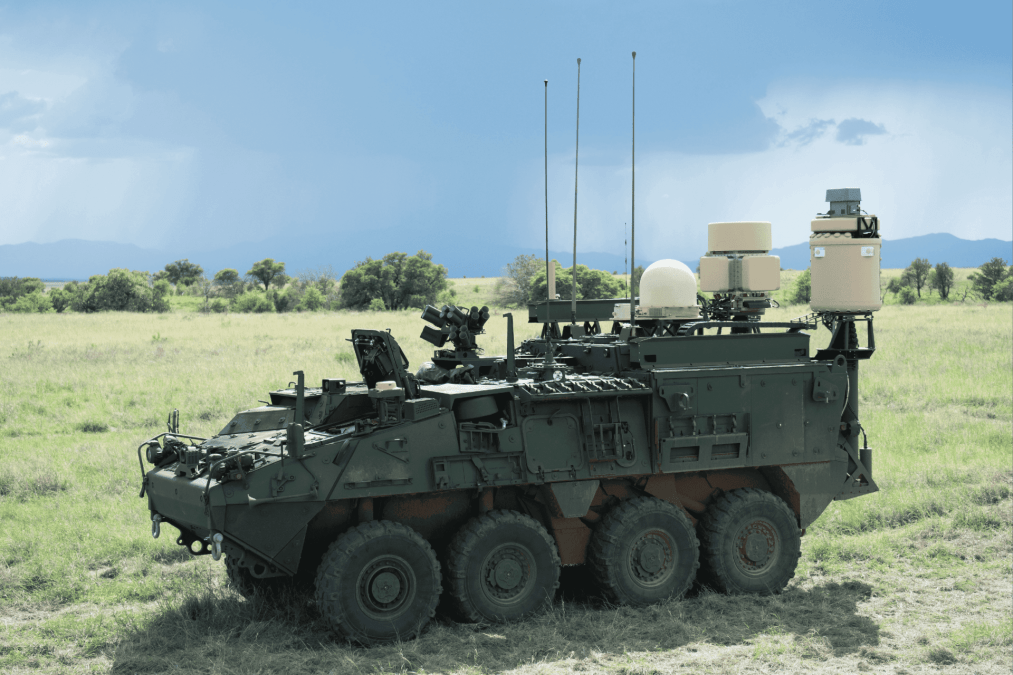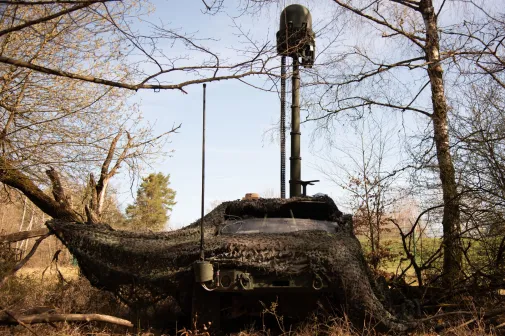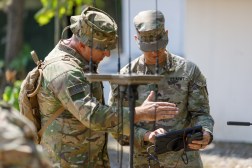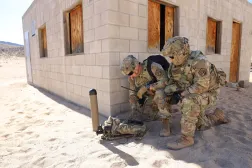Army plans to split up signals intelligence, electronic warfare platform

This is part one of a three-part series examining how the Army is approaching electronic warfare and applying its “transforming in contact” concept — which uses deployments and troop rotations to test new equipment — to EW.
PHILADELPHIA — Following years of development, the Army intends to break up its integrated signals intelligence and electronic warfare platform into two distinct variants.
The Terrestrial Layer System-Brigade Combat Team was designed as the first integrated signals intelligence, cyber and EW platform devised roughly six years ago. It has been described as a key enabler of Army priorities — considering the service has been without a program-of-record jammer for decades — that will support multi-domain operations. As initially conceived, it was to be mounted on Stykers and then Army Multi-Purpose Vehicle variant prototypes.
Outside experts had always voiced concern with such a setup given the highly classified nature and authorities that come with signals intelligence and the issues associated with putting that on the same platform as electronic warfare tools.
The Army awarded a middle tier acquisition contract to Lockheed Martin for the platform five years ago. Officials explained that the breakup of the TLS-BCT demonstrates the benefit of this MTA approach — which at the conclusion could lead to rapid fielding, transitioning to a major capability acquisition, continue prototyping through other means, or termination — and the authorities Congress has granted the Army.
“It’s the beauty of the MTA process. It allows you to learn what’s not going to work or what’s not going to be successful in the fight. That kind of aggregation of SIGINT and EW physically located presented a multitude of challenges. The reality was that the best path was to have them separated, not on a single platform,” Brig. Gen. Wayne “Ed” Barker, program executive officer for intelligence, electronic warfare and sensors, said in an interview at the Army’s Technical Exchange Meeting in Philadelphia this week.
That existing MTA will conclude next year, meaning there will not be a rapid fielding decision on TLS at that time. The Army will continue prototyping on both an electronic warfare and signals intelligence variant over the course of a 12 to 18-month period outside that MTA period to refine what those capabilities look like.
At the end of that time frame, depending on how far the Army has progressed from a prototype for each variant, a decision will be made determining if one or both of those platforms is mature enough to go into a rapid fielding or transitions into a major capability acquisition.
The changing nature of the EW environment
Currently, the more stable of the two systems is the signals intelligence system from a requirements and platform standpoint, which would simply require the removal of the electronic warfare payload from the platform.
The Army has been undergoing a years-long rejuvenation of EW following significant divestments at the end of the Cold War. Russia’s invasion of Ukraine in 2014 spurred a hastening of those efforts after it was determined their systems and concepts were in many cases more mature than those of the Army.
Conversely, for decades, the Army has had a series of platform-based signals intelligence systems, such as Prophet, a ground-based tactical SIGINT system.
One of the critical and ongoing lessons coming from Ukraine is that the EW environment is changing rapidly. The Army’s chief of staff is directing the service to prioritize electronic warfare equipment to soldiers to experiment with via a concept called “transforming in contact,” where the Army plans to use deployments and troop rotations to test new equipment — mainly commercial off-the-shelf gear — to allow units to be more responsive on a dynamic battlefield.
“We’re learning that the EW landscape is changing everywhere between three weeks and three months, and so that we need to be more flexible in our approach … The battlefield is changing really, really rapidly,” George said during testimony before the Senate Armed Services Committee in April.
While the European theater had been the priority for a long time, the Army is now beginning to turn its focus to the Pacific as well, where the Department of Defense refers to China as the pacing threat.
Given that the threat — both in Europe and the Pacific — is changing, combined with the terrain in each theater, a relook at capabilities is necessary, officials have said.
Moreover, larger platforms such as Strykers and AMPVs don’t island-hop as easily in the Pacific, which includes thousands of islands spread across thousands of miles in maritime and jungle environments.
“This is one area where the technology just isn’t necessarily there. The prototyping actually creates a demand signal back to industry to go, ‘Hey, our challenge is a couple of things,’” Alex Miller, chief technology officer for the chief of staff, said in an interview at the Technical Exchange Meeting. “One, we have some older kit that has really proprietary interfaces and control mechanisms, and we don’t want that. We want something that’s more open. Two, when you’re on a vehicle you have access to a lot more power [and] we want you to be able to use that power to create either the effect of protecting or the effect of attacking.”
He noted that at experiments such as Project Convergence, the Army saw a lot of newer capabilities such as robotically mounted or small drone-mounted electronic warfare, that were promising.
“That’s the real truth is we need help on that technology on that mounted, high power, mobile type of EW kit versus the Manpack, which is a little bit more low power,” Miller said, adding they can throw an electronic warfare kit onto a pickup truck or an Infantry Squad Vehicle that is more mobile and transportable through C-130 or C-17 lift.
The Manpack version he mentioned was envisioned as a complement to the TLS-BCT system encompassing a series of two systems dismounted soldiers can use for jamming, signal direction finding and signals intelligence. The Army awarded a $1.5 million contract to Mastodon Design, a CACI subsidiary, last year.
There has been a rapid fielding decision made on the Manpack with first unit equipped scheduled for later this year, Barker said, adding: “When you think of it in terms of that transforming in contact, this is the real first piece of kit that we’re getting in the hands of folks.”
Miller also explained that the Army is trying to get out of the business of “gold-plating” requirements where “perfect” becomes the enemy of “good enough.”
“Part of the reason that the IEW&S team were forced to make the decision is because the alternative was try to get it perfect and never revealed anything. And that’s wrong. Soldiers deserve better than that,” he said. “Being able to say the operational environment has changed, we need to stop gold-plating requirements, we need to get the smallest requirement out the door so [Barker] can prototype — that’s another part of it. And that goes back to the transform in contact and how do we iterate on requirements and how do we give a piece of kit to soldiers and formations so they can give feedback more rapidly?”
On the acquisition side, Barker noted that Doug Bush – assistant secretary of the Army for acquisition, logistics and technology — has been clear that he would rather have these types of conversations now during the MTA and realize this is something the Army doesn’t want, instead of going through a major capability acquisition and trying to deliver something to the field years later that doesn’t meet the need.
“One of the key criteria they enter into an MTA is the ability to demonstrate a successful prototype. That’s what the vendors are held accountable to. If it appears that we won’t have a successful prototype, then then the Army has the right to recompete if we want [or] if we need to,” Barker said.
Moreover, the service is rethinking what it means to field something, which historically had very specific acquisition and programmatic connotations.
“We’re getting so much new and useful kit to soldiers so often that it’s no longer a pickup game on a soldier touch point once a year. It is now, ‘Here’s this kit, you keep it if it’s useful to you,’ and they use it and they provide feedback until the next piece of kit comes and they’re using that. That’s the continuous transformation,” Miller said. “The notion that, hey, you only see the output five years at the very end of the MTA — that’s no longer the case. As soon as there’s something useful, we want feedback.”
Additionally, the Army Force Structure Transformation plan that was released in February also made changes to electronic warfare forces regarding the placement of EW companies and platoons at certain echelons, which will inform changes to the platform.
Part two of this series will focus on how the Army is evaluating electronic warfare technology, who is in charge and how to get kit into the hands of soldiers faster.






